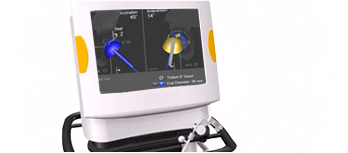Patella Stabilization (Fulkerson) Osteotomy
Indication and Procedure Description
This procedure is indicated for those patients who have recurrent episodes of patella dislocation. The procedure is considered after multiple episodes where the patella dislocates with minimal activity. The procedure is also occasionally indicated for those patients who have patellofemoral (anterior) knee pain; however the improvement in pain following this can be unpredictable. The procedure involves moving the bony attachment of the patella tendon on the tibia to a more medial (inner) and anterior (forward) position, combined with releasing the tight tissues on the lateral (outside) aspect of the patella. This allows the patella to run in a more normal position, thereby preventing lateral dislocation. The bony portion of the patella tendon attachment of the tibia is called the tibial tubercle. Once this has been moved, it is securely re-attached with two screws.
Pre-Operative Preparation
X-rays will be obtained peri-operatively. It will also include a skyline X-ray of the patella to assess its location with respect to the knee. Occasionally CT scans are also obtained to allow a better determination of the degree of dislocation and bony anatomy.
Hospital Stay
On the day of surgery, the limb will be marked. The procedure requires a general
anesthetic and is supplemented by a femoral nerve block which will control the pain post-operatively.
Following the procedure, the knee will initially be held in a straight splint. Physiotherapy is begun immediately to help with mobilization. The patient is encouraged to weight bear as tolerated through the leg. The splint will be required on the knee until the patient can comfortably straight leg raise, which will occur within the first ten days. The knee will be removed from the splint by the physiotherapist after the outside dressings have been removed to allow knee bending. A drain will have been placed in the knee during surgery and this will be removed on the first day following the surgery.
Most patients will be discharged on the second or third day following surgery. Appointments will be made for a visit within the first two weeks to assess the wound, and then subsequent visits at six weeks and three months following the surgery. The patient will have X-rays performed at both of these subsequent visits.
Post-operative Care
Knee Brace. A knee brace is generally required for approximately two weeks. It will be removed for exercises in this time. It will be removed permanently once the patient can comfortably straight leg raise.
Weight bearing. The patient will be weight bearing as tolerated for the first four weeks and will require crutches generally for this time to protect the osteotomy.
Exercises
Physiotherapy is commenced early with the emphasis on static quadriceps and hamstring work to maintain muscle bulk. Early work is also directed at mobility of the patella to prevent tethering and scarring of the soft tissues around the patella.
Range of motion exercises are also begun early with the aim of having 90° of bend by two weeks and full flexion by six weeks.
It is expected that fast walking can be commenced by two months and a return to running and sporting activities by four to six months post-surgery. |















